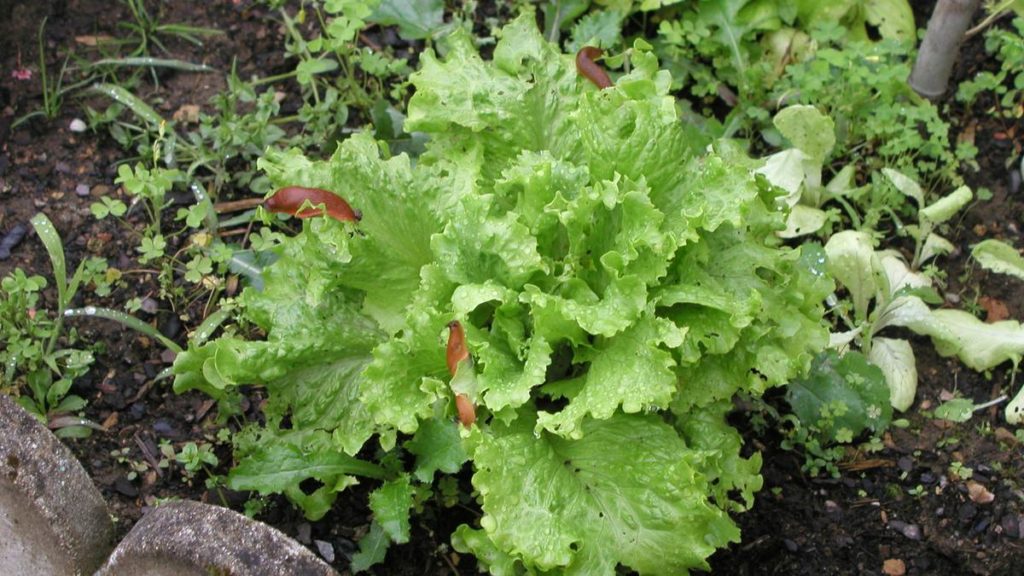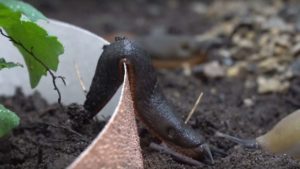Slugs and snails, words to bring fear to any gardener’s heart! It’s been a good year in the endless slug war so far but warm wet weather is ideal for the slimy devils. What to do?
There are lots of remedies and natural controls advocated for keeping plants safe from slugs and snails but not all of them actually work. Back in 2019 the RHS undertook a study of five popular organic home slug control methods and found them to not be effective.
Copper tape, horticultural grit, pine bark mulch, wool pellets and egg shells were all shown to make no difference when applied to lettuce, with gastropods inflicting the same damage to those treated with the remedies as without.
Copper tape is supposed to create a static electricity barrier that the slug won’t cross but as the photo shows, they’re not that bothered by it. Sadly the same goes for the other barrier methods in the list above.
Well the people at Envii make an organic slug control method called Feed & Fortify that uses diatomaceous earth to naturally protect plants from slugs, snails and other small pests. It also contains iron silicates to improve soil fertility and maximise plant growth.
They decided to replicate the RHS study on the slug barriers and also put their Feed & Fortify to the test. The video answers the ‘does it work?’ question (spoiler alert!) – it works.
The feed part of the name – the Iron Silicates – might benefit from a little explanation.
Iron for Plants
Iron is an important micro-nutrient for plants. A sort of plant vitamin. They only need a very small amount, but that small amount is crucial to healthy growth. Iron is utilised in the production of chlorophyll which is the engine that converts carbon dioxide to carbon and oxygen and feeds the plant as well as giving it the green colour.
A lack of iron will show itself as yellowing on the leaves and a sickly plant.
Silicon
Silicon is a common element that aids plant growth and quality, photosynthesis, transpiration and enhances plant resistance to stresses such as drought. (see this article from Greenhouse Management) Plants grown in commercial potting composts – patio pots, hanging baskets etc. – are most likely to be in need of supplemental silicon.
Natural Slug and Snail Controls
Seeing is believing and the film below shows how the slugs react when faced with different barrier methods.






I have read somewhere that if you cook with garlic dilute the juices and spray the ground with it this kills slugs and their egg is this true
I doubt it
Isn’t diatomaceous earth harmful to bees? They have enough problems already.
Not that I’ve heard. Remember it’s being used on the ground and bees tend to be above that as they fly to the flowers
I have noticed less bees on my flower pots – does this product deter slugs but also bees?
No Gabriele, it doesn’t deter bees. See other comments
We bordered all our raised beds with double bands of serrated copper-tape which is not cheap: then watched during a tea break as the critters just slithered over the two bands. So will give this diatomaceous earth a try. I hear it needs a top-up after every bit of rain? Could be back to the old night patrol with torch and boots! What does work is instant mash potato, the cheapest supermarket kind. Leave dry in little covered saucers with slug access and they go for it big time. I believe they get so thirsty that they then drink big time and the mash swells up and explodes them! I haven’t seen this wonderful spectacle but they do really take the bait and their numbers seemed less.
I can’t imagine what the RHS did when they tested copper rings. I’ve used them for years and they work for me, the only thing I can think of is that they failed to put a few slug pellets inside when they put them on. It is possible to trap a slug inside when you set things up and so it will eat your plant. We used the soil association approved pellets.
Have you seen the video with the slug happily sliming over the copper band? Or was I stupidly missing a joke? “…they failed to put a few slug pellets inside” 🙂
Well the slugs won’t cross the copper rings I use, the pellets put in at the setup prevent and slug that is under the soil inside the ring when you put it in doing any harm there after the ring prevents slugs coming in from outside. They work for me.
I am still not sure about this; the Wiki entry mentions dehydration of anything with an exoskeleton and certain types causing silicosis albeit most available now is safer.
https://en.wikipedia.org/wiki/Diatomaceous_earth
Envii have commented on this concern:
I was told to plant garlic and onions around the edges of all the plots to reduce the number of slugs moving in. I don’t think it does, but it is a convenient and sace-saving way of growing the garlic.
We just use dried minced garlic spread like slug pellets. It works exactly the same. Bit smellier but not for long and lasts about the same in similar conditions. Of course you have to buy it in big bags from Ebay or somewhere similar to make it affordable but it works for us.